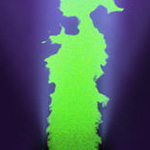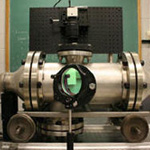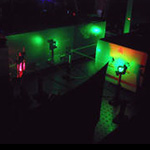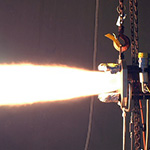The Propulsion and Combustion Engineering Laboratory (PACE) at U-M is centrally located in the François-Xavier Bagnoud (FXB) Building, a highly modern 100,000 square-foot complex that includes classrooms, teaching laboratories, research laboratories, faculty and staff offices, and a student learning center. Several supporting buildings enhance our mission including the wind tunnel facility and the Plasmadynamic and Propulsion Lab facility.
The FXB Building contains four blast-resistant hardened laboratories that are used for potentially hazardous experiments as part of the Department's research in high-energy propellant combustion, relevant to advanced propulsion systems; detonation-wave phenomena, relevant to hypersonic propulsion systems; and both explosion and detonation-wave phenomena, relevant to safety concerns. These hardened laboratory facilities are unique and will allow continuation of a long tradition of research leadership in these areas by the Department of Aerospace Engineering.


This laboratory conducts research into fundamental aspects of turbulent combustion. It is home to the Cinema Stereoscopic Particle Image Velocimitry (CS-PIV) system along with more traditional diagnostics such as LDV. The CS-PIV system allows direct measurement of the three component vorticity field and flame position in a plane with both high spatial (over 2 mega-pixels in 2cm2) and temporal (several kHz) resolution. It is comprised of multiple Phantom 9.0 high-speed digital cameras, ORC-1000 high-rep-rate Nd:YAG lasers, Schiemplflug adapters, macro-lenses, with a variety of optics and data-processing equipment. Various burner configurations can be studied including Bunsen, swirl, and jet flames. Diagnostics such as PLIF, Mie-scattering, and Schlieren photography are also often employed.

This lab houses the model gas turbine combustor with a GE TAPS injector provided by GEAE. A novel combustor design allows for large optical access with capabilities for high flow rates at elevated temperatures and pressures. The air is pre-heated via a 250 kW heater and the combustor can be pressurized up to 10 atm. Options for fuel range from Jet A to a variety of gaseous fuels. The lab also contains two high power Nd:YAG lasers, a dye laser, two intensified CCD cameras (Andor 1k x 1k), and a PIV camera (LaVision 2k x 2k) for advanced laser diagnostics. These lasers and cameras allow for simultaneous measurements of the flow field and reaction zone via techniques such as PLIF (of CH, OH, CH2O, or CO) and PIV.

The Michigan Supersonic Combustion Lab consists of a blow-down type wind tunnel allowing up to 30 minutes of run time per tank of air. A 250 kW electric resistance heater can supply clean, radical-free air to the test section at temperatures up to 700 F. A natural gas fueled vitiator extends the attainable air temperatures up to around 2000 F. A dedicated exhaust safely removes the hot combustion products. A number of test sections can be used in the facility allowing the study of supersonic jet flames, scramjet cavity flame-holders, and scramjet combustors. A typical test area cross section of these combustors is 1.5 in by 1.5 in. Current diagnostic capabilities in the lab include PIV and PLIF of various combustion radicals (CH, OH, CH20)

The Michigan Single Element Rocket Facility is a laboratory scale rocket engine designed to study mixing and combustion at moderate chamber pressures of 1 to 10 atmospheres. This facility is capable of oxygen flow rates up to 5g/s and hydrogen flow rates up to 2g/s. In addition to hydrogen, methane can also be used. A window section, along with the modular design of the rocket, allows optical access for laser diagnostic techniques over the entire combustion chamber length. Water cooling in the nozzle and copper walls allows test times of up to 10 seconds. Current diagnostic equipment include a Nd:YAG laser, a Dye laser, and non-intensified and intensified cameras. This equipment allows visual flame techniques along with Acetone, OH, and NO PLIF to be performed.